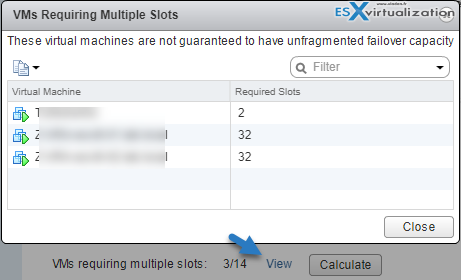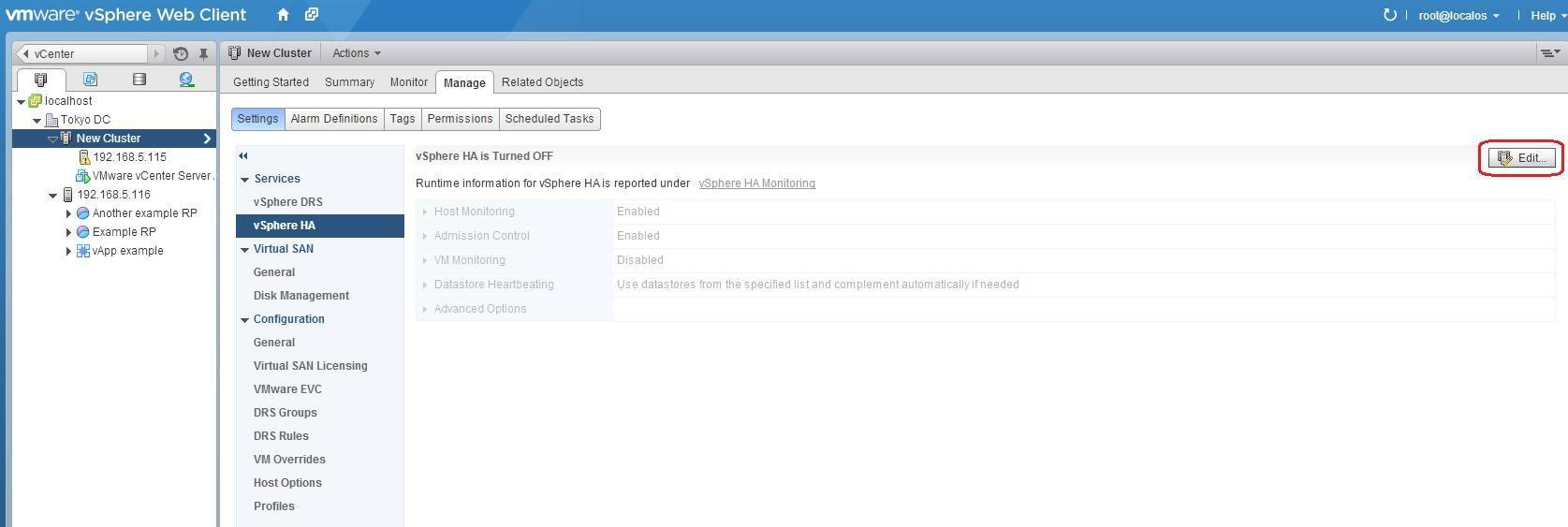Vmware Slot Size Policy
By Duncan Epping, Principal Architect, VMware
Vmware Ha Slot Size only then will Vmware Ha Slot Size you be able to cash out winnings from the bonus. The rules matter: It is important to be aware of the rules associated Vmware Ha Slot Size with the bonus to be able to use it properly. The most common of these apart from the wagering requirement is the list of eligible games for the bonus. If I go to run time info of cluster in vmware I can it has used 32MHz 1, Virtual CPU and 40MB memory slot size. Then it says total slot is 691 and failover slot is 422. I tried both by using slot size of 32Mhz and 40MB memory and also using highest assigned cpu and memory in the powered on VMs but none of these calculation give the vlaue as in.
Yesterday I received a question on twitter:
Hi, to settle an argument in the office, if no reserves are in place, does number of vCPU’s affect slot size in vSphere 4? Thx 🙂
First of all, what is a slot? The availability guide explains it as follows
A slot is a logical representation of the memory and CPU resources that satisfy the requirements for any powered-on virtual machine in the cluster.
In other words a slot is the worst case CPU and Memory reservation scenario for any given virtual machine in a cluster. This slot is used when Admission Control is enabled and “Host Failures Tolerates” has been selected as the admission control policy. The total amount of available resources in the cluster will be divided by the slot size and that dictates how many VMs can be powered on without violating availability constraints. Meaning that it will guarantee that every powered on virtual machine can be failed over.
As said this slot is dictated by the worst case reservation for CPU and Memory. Prior to vSphere 4.0 we used the number of vCPUs to determine the slotsize for CPU as well. But we do not use vCPUs anymore to determine the slot size for CPU. The slotsize for CPU is determined by the highest reservation or 256MHz (vSphere 4.x and prior) / 32MHz (vSphere 5) if no reservation is set.
However, vCPUs can have an impact on your slot… it can have an impact on your memory slotsize. If no reservation is set anywhere HA will use the highest Memory Overhead in your cluster as the slot size for memory. This is where the amount of vCPUs come in to play, the more vCPUs you add to a virtual machine the higher will your memory overhead be.
I guess the answer to this question is: For CPU the number of vCPUs does not impact your slotsize, but for memory it may.
What is VMware HA?
As per VMware Definition,
VMware® High Availability (HA) provides easy to use, cost effective high availability for applications running in virtual machines. In the event of server failure, affected virtual machines are automatically restarted on other production
Vmware Slot Size Policy Tool
servers with spare capacityDownload Now and Complete your End to End P2v Migrations using VMware Arena’s “P2V ADMIN ISO“
What is AAM in HA?
AAM is the Legato automated availability management. Prior to vSphere 4.1, VMware’s HA is actually re engineered to work with VM’s with the help of Legato’s Automated Availability Manager (AAM) software. VMware’s vCenter agent (vpxa) interfaces with the VMware HA agent which acts as an intermediary to the AAM software. From vSphere 5.0, it uses an agent called “FDM” (Fault Domain Manager).
What are pre-requites for HA to work?
1.Shared storage for the VMs running in HA cluster
2.Essentials plus, standard, Advanced, Enterprise and Enterprise Plus Licensing
3.Create VMHA enabled Cluster
4.Management network redundancy to avoid frequent isolation response in case of temporary network issues (preferred not a requirement)
What is maximum number of primary HA hosts in vSphere 4.1?
Maximum number of primary HA host is 5. VMware HA cluster chooses the first 5 hosts that joins the cluster as primary nodes and all others hosts are automatically selected as secondary nodes.
How to see the list of Primary nodes in HA cluster?
View the log file named “aam_config_util_listnodes.log” under /var/log/vmware/aam using the below command
cat /var/log/vmware/aam/aam_config_util_listnodes.log
What is the command to restart /Start/Stop HA agent in the ESX host?
servicevmware–aam restart
servicevmware–aam stop
servicevmware–aam start
Where to located HA related logs in case of troubleshooting?
/Var/log/vmware/aam
What the basic troubleshooting steps in case of HA agent install failed on hosts in HA cluster?

Below steps are are taken from my blog posts Troubleshooting HA
1. Check for some network issues

2. Check the DNS is configured properly
3. Check the vmware HA agent status in ESX host by using below commands
servicevmware–aam status
4. Check the networks are properly configured and named exactly as other hosts in the cluster. otherwise, you will get the below errors while installing or reconfiguring HA agent.
5. Check HA related ports are open in firewall to allow for the communication
Incoming port: TCP/UDP 8042-8045
Outgoing port: TCP/UDP 2050-2250
6. First try to restart /stop/start the vmware HA agent on the affected host using the below commands. In addition u can also try to restart vpxa and management agent in the Host.
servicevmware–aam restart
servicevmware–aam stop
servicevmware–aam start
7. Right Click the affected host and click on “Reconfigure for VMWare HA” to re-install the HA agent that particular host.
8. Remove the affected host from the cluster. Removing ESX host from the cluster will not be allowed untill that host is put into maintenance mode.
9.Alternative solution for 3 step is, Goto cluster settings and uncheck the vmware HA in to turnoff the HA in that cluster and re-enable the vmware HA to get the agent installed.
10. For further troubleshooting , review the HA logs under /Var/log/vmware/aam directory.
What is the maximum number of hosts per HA cluster?
Maximum number of hosts in the HA cluster is 32
What is Host Isolation?
VMware HA has a mechanism to detect a host is isolated from rest of hosts in the cluster. When the ESX host loses its ability to exchange heartbeat via management network between the other hosts in the HA cluster, that ESX host will be considered as a Isolated.
How Host Isolation is detected?
In HA cluster, ESX hosts uses heartbeats to communicate among other hosts in the cluster.By default, Heartbeat will be sent every 1 second.
If a ESX host in the cluster didn’t received heartbeat for for 13 seconds from any other hosts in the cluster, The host considered it as isolated and host will ping the configured isolation address(default gateway by default). If the ping fails, VMware HA will execute the Host isolation response
What are the different types isolation response available in HA?
Power off – All the VMs are powered off , when the HA detects that the network isolation occurs
Shut down – All VMs running on that host are shut down with the help of VMware Tools, when the HA detects that the network isolation occurs.If the shutdown via VMWare tools not happened within 5 minutes, VM’s power off operation will be executed. This behavior can be changed with the help of HA advanced options. Please refer my Post on HA Advanced configuration
Leave powered on – The VM’s state remain powered on or remain unchanged, when the HA detects that the network isolation occurs.
How to add additional isolation address for redundancy?
By default, VMWare HA use to ping default gateway as the isolation address if it stops receiving heartbeat.We can add an additional values in case if we are using redundant service console both belongs to different subnet.Let’s say we can add the default gateway of SC1 as first value and gateway of SC2 as the additional one using the below value
1. Right Click your HA cluster
2. Goto to advanced options of HA
3. Add the line “das.isolationaddress1 = 192.168.0.1″
Vmware Slot Size Policy Guide
4. Add the line “das.isolationaddress2 = 192.168.1.1″ as the additional isolation address
To know more about the Advanced HA Options
What is HA Admission control?
As per “VMware Availability Guide”,
VCenter Server uses admission control to ensure that sufficient resources are available in a cluster to provide failover protection and to ensure that virtual machine resource reservations are respected.
What are the 2 types of settings available for admission control?
Enable: Do not power on VMs that violate availability constraints
Disable: Power on VMs that violate availability constraints
What are the different types of Admission control policy available with VMware HA?
There are 3 different types of Admission control policy available.
Host failures cluster tolerates
Percentage of cluster resources reserved as fail over spare capacity
Specify a fail over host
How the Host Failures cluster tolerates admission control policy works?
Select the maximum number of host failures that you can afford for or to guarantee fail over. Prior vSphere 4.1, Minimum is 1 and the maximum is 4.
In the Host Failures cluster tolerates admission control policy , we can define the specific number of hosts that can fail in the cluster and also it ensures that the sufficient resources remain to fail over all the virtual machines from that failed hosts to the other hosts in cluster. VMware High Availability(HA) uses a mechanism called slots to calculate both the available and required resources in the cluster for a failing over virtual machines from a failed host to other hosts in the cluster.

What is SLOT?
As per VMWare’s Definition,
“A slot is a logical representation of the memory and CPU resources that satisfy the requirements for any powered-on virtual machine in the cluster.”
If you have configured reservations at VM level, It influence the HA slot calculation. Highest memory reservation and highest CPU reservation of the VM in your cluster determines the slot size for the cluster.
How the HA Slots are Calculated?

I have written a post about how the HA slots are calculated.
How to Check the HA Slot information from vSphere Client?
Click on Cluster Summary Tab and Click on “Advanced Runtime Info” to see the the detailed HA slots information.
What is use of Host Monitoring status in HA cluster?
Let’s take an example, you are performing network maintenance activity on your switches which connects your one of th ESX host in HA cluster.
what will happen if the switch connected to the ESX host in HA cluster is down?
It will not receive heartbeat and also ping to the isolation address also failed. so, host will think itself as isolated and HA will initiate the reboot of virtual machines on the host to other hosts in the cluster. Why do you need this unwanted situation while performing scheduled maintenance window.
To avoid the above situation when performing scheduled activity which may cause ESX host to isolate, remove the check box in ” Enable Host Monitoring” until you are done with the network maintenance activity.
How to Manually define the HA Slot size?
By default, HA slot size is determined by the Virtual machine Highest CPU and memory reservation. If no reservation is specified at the VM level, default slot size of 256 MHZ for CPU and 0 MB + memory overhead for RAM will be taken as slot size. We can control the HA slot size manually by using the following values.
There are 4 options we can configure at HA advanced options related to slot size
das.slotMemInMB – Maximum Bound value for HA memory slot size
das.slotCpuInMHz – Maximum Bound value for HA CPU slot Size
das.vmMemoryMinMB – Minimum Bound value for HA memory slot size
das.vmCpuMinMHz – Minimum Bound value for HA CPU slot size
For More HA related Advanced options, Please refer my blog post
How the “Percentage of cluster resources reserved as failover spare capacity” admission control policy works?
Vmware Slot Size Policy Comparison
In the Percentage of cluster resources reserved as failover spare capacity admission control policy, We can define the specific percentage of total cluster resources are reserved for failover.In contrast to the “Host Failures cluster tolerates admission control policy”, It will not use slots. Instead This policy calculates the in the way below
Vmware Slot Size Policy Chart
1.It calculates the Total resource requirement for all Powered-on Virtual Machines in the cluster and also calculates the total resource available in host for virtual machines.
2.It calculates the current CPU and Memory Failover capacity for the capacity.
3.If the current CPU and Memory Failover capacity for the cluster < configured failover capacity (ex 25 %)
4.Admission control will not allow to power on the virtual machine which violates the availability constraints.
How the “Specify a failover host” admission control policy works?
In the Specify a failover host” admission control policy, We can define a specific host as a dedicated failover host. When isolation response is detected, HA attempts to restart the virtual machines on the specified failover host.In this Approach, dedicated failover hist will be sitting idle without actively involving or not participating in DRS load balancing.DRS will not migrate or power on placement of virtual machines on the defined failover host.
What is VM Monitoring status?
HA will usually monitors ESX hosts and reboot the virtual machine in the failed hosts in the other host in the cluster in case of host isolation but i need the HA to monitors for Virtual machine failures also. here the feature called VM monitoring status as part of HA settings.VM monitoring restarts the virtual machine if the vmware tools heartbeat didn’t received with the specified time using Monitoring sensitivity.
If you are looking for more VMware interview questions Please click Interview Questions.
Thanks For Reading!!! All the Best…